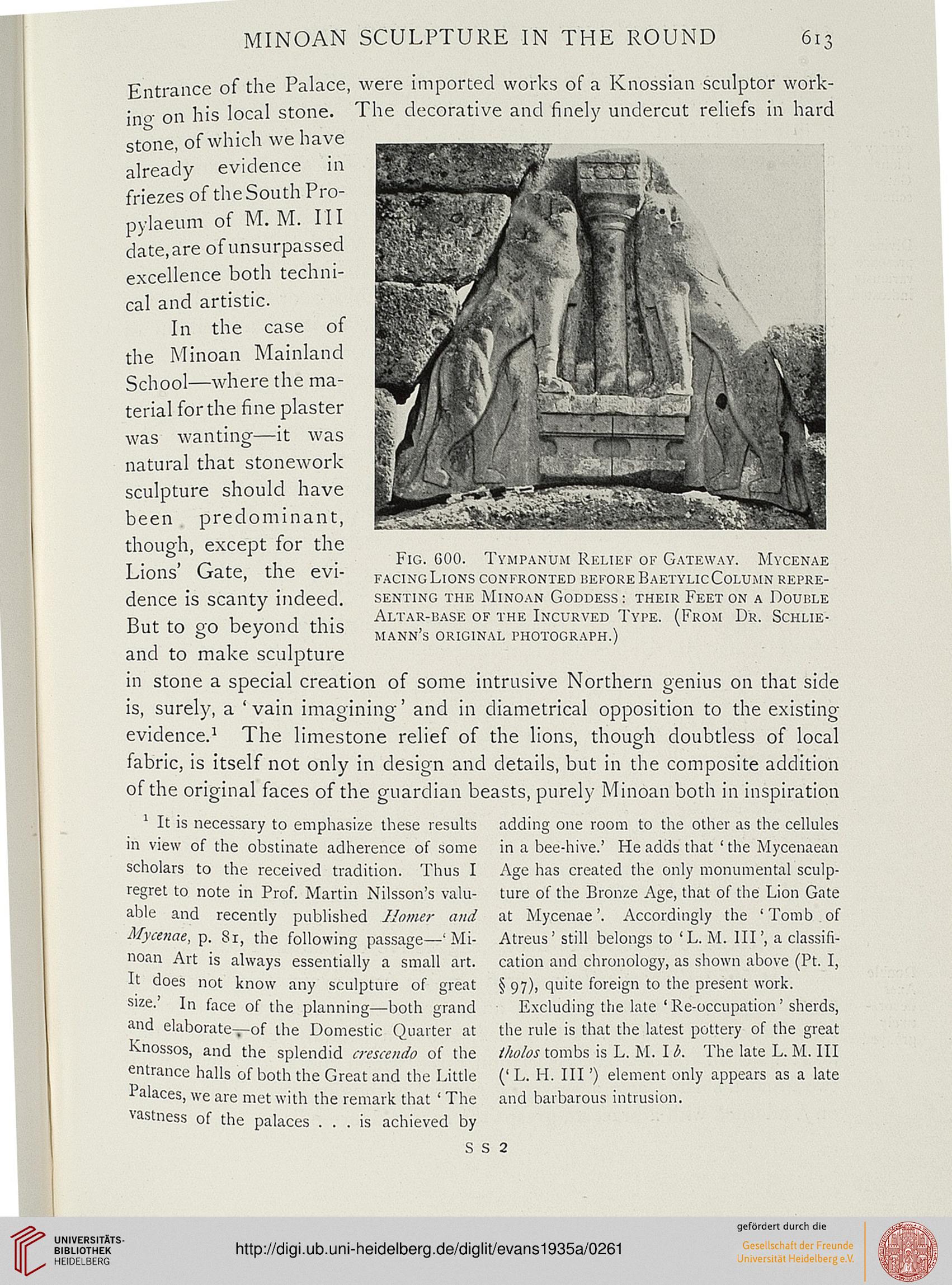MINOAN SCULPTURE IN THE ROUND
6li
Entrance of the Palace, were imported works of a Knossian sculptor work-
ino- on his local stone. The decorative and finely undercut reliefs in hard
stone, of which we have
already evidence in
friezes of the South Pro-
pylaeum of M. M. Ill
date, are of unsurpassed
excellence both techni-
cal and artistic.
In the case of
the Minoan Mainland
School—where the ma-
terial for the fine plaster
was wanting—it was
natural that stonework
sculpture should have
been predominant,
though, except for the
Lions' Gate, the evi-
dence is scanty indeed.
But to go beyond this
and to make sculpture
in stone a special creation of some intrusive Northern genius on that side
is, surely, a ' vain imagining' and in diametrical opposition to the existing
evidence.1 The limestone relief of the lions, though doubtless of local
fabric, is itself not only in design and details, but in the composite addition
of the original faces of the guardian beasts, purely Minoan both in inspiration
1 It is necessary to emphasize these results
in view of the obstinate adherence of some
scholars to the received tradition. Thus I
Fig. GOO. Tympanum Relief of Gateway. Mycenae
facing Lions confronted before Baetylic Column repre-
senting the Minoan Goddess : their Feet on a Double
Altar-base of the Incurved Type. (From Dr. Schlie-
mann's original photograph.)
regret to note in Prof. Martin Nilsson's valu-
able and recently published Homer and
Mycenae, p. Si, the following passage—'Mi-
noan Art is always essentially a small art.
It does not know any sculpture of great
size.' In face of the planning—both grand
and elaborate—of the Domestic Quarter at
Knossos, and the splendid crescendo of the
entrance halls of both the Great and the Little
Palaces, we are met with the remark that ' The
vastness of the palaces ... is achieved by
adding one room to the other as the cellules
in a bee-hive.' He adds that ' the Mycenaean
Age has created the only monumental sculp-
ture of the Bronze Age, that of the Lion Gate
at Mycenae'. Accordingly the 'Tomb.of
Atreus' still belongs to 'L. M. Ill', a classifi-
cation and chronology, as shown above (Pt. I,
§ 97), quite foreign to the present work.
Excluding the late 'Re-occupation' sherds,
the rule is that the latest pottery of the great
tholos tombs is L. M. I b. The late L. M. Ill
(' L. H. Ill') element only appears as a late
and barbarous intrusion.
6li
Entrance of the Palace, were imported works of a Knossian sculptor work-
ino- on his local stone. The decorative and finely undercut reliefs in hard
stone, of which we have
already evidence in
friezes of the South Pro-
pylaeum of M. M. Ill
date, are of unsurpassed
excellence both techni-
cal and artistic.
In the case of
the Minoan Mainland
School—where the ma-
terial for the fine plaster
was wanting—it was
natural that stonework
sculpture should have
been predominant,
though, except for the
Lions' Gate, the evi-
dence is scanty indeed.
But to go beyond this
and to make sculpture
in stone a special creation of some intrusive Northern genius on that side
is, surely, a ' vain imagining' and in diametrical opposition to the existing
evidence.1 The limestone relief of the lions, though doubtless of local
fabric, is itself not only in design and details, but in the composite addition
of the original faces of the guardian beasts, purely Minoan both in inspiration
1 It is necessary to emphasize these results
in view of the obstinate adherence of some
scholars to the received tradition. Thus I
Fig. GOO. Tympanum Relief of Gateway. Mycenae
facing Lions confronted before Baetylic Column repre-
senting the Minoan Goddess : their Feet on a Double
Altar-base of the Incurved Type. (From Dr. Schlie-
mann's original photograph.)
regret to note in Prof. Martin Nilsson's valu-
able and recently published Homer and
Mycenae, p. Si, the following passage—'Mi-
noan Art is always essentially a small art.
It does not know any sculpture of great
size.' In face of the planning—both grand
and elaborate—of the Domestic Quarter at
Knossos, and the splendid crescendo of the
entrance halls of both the Great and the Little
Palaces, we are met with the remark that ' The
vastness of the palaces ... is achieved by
adding one room to the other as the cellules
in a bee-hive.' He adds that ' the Mycenaean
Age has created the only monumental sculp-
ture of the Bronze Age, that of the Lion Gate
at Mycenae'. Accordingly the 'Tomb.of
Atreus' still belongs to 'L. M. Ill', a classifi-
cation and chronology, as shown above (Pt. I,
§ 97), quite foreign to the present work.
Excluding the late 'Re-occupation' sherds,
the rule is that the latest pottery of the great
tholos tombs is L. M. I b. The late L. M. Ill
(' L. H. Ill') element only appears as a late
and barbarous intrusion.





